
Related
Guests
- James Northlongtime reporter who has covered Africa for almost four decades. He is a contributing writer to The Nation magazine.
A massive humanitarian crisis is unfolding in Central Africa, where fighting has displaced tens of thousands in the Democratic Republic of Congo. Rebels believed to be backed by Rwanda postponed their departure Friday from Goma for “logistical reasons,” defying for a second time an ultimatum set by neighboring African countries and backed by Western diplomats. Last week, the World Food Program suspended its food distribution over security concerns, but it has now resumed activity in several refugee camps across the Congo. Meanwhile, many who fled their homes amidst the fighting are looking to return, but thousands are still living in camps as the conflict drags on. “It’s one of the greatest humanitarian crises anywhere in the world since the end of World War II. Some five million people have died since 1998 when serious fighting broke out again in the region,” says veteran reporter James North, who has covered Africa for almost four decades. He is a contributing writer to The Nation, where his latest article is “Washington’s Role in the Renewed Violence in DR Congo.” [includes rush transcript]
Transcript
JUAN GONZÁLEZ: We turn now to the massive humanitarian crisis unfolding in Central Africa, where fighting has displaced tens of thousands in the Democratic Republic of Congo. Rebels in Congo believed to be backed by Rwanda postponed their departure Friday from the key eastern city of Goma by 48 hours for “logistical reasons,” defying for a second time an ultimatum set by neighboring African countries and backed by Western diplomats. The move marks their second defiance of a demand by African leaders for them to retreat.
Last week, the World Food Program suspended its distribution over security concerns, but it has now resumed activity in several refugee camps across the Congo. This is Wolfram Herfurth of the World Food Program.
WOLFRAM HERFURTH: Today we are assisting in 12 sites some 80,000 people with a three-day ration of maize-meal powders, oil and salt. They are all war-displaced population. Some of them are going home to their origin in Rutshuru. Others are forced still to stay in the camps.
JUAN GONZÁLEZ: Meanwhile, many who fled their homes amidst the fighting are looking to return, but thousands are still living in camps as the conflict drags on.
MUNAZO ROSSET: [translated] The most important thing for us is peace. We want to go back to our homes, because we grow our own food and do not depend on anyone. The food is too little here, and we are meant to share it for three days.
AMY GOODMAN: Well, for more on the conflict and what’s driving it, I spoke Thursday with veteran reporter James North, who’s covered Africa for almost four decades, contributing writer to The Nation, where his latest piece is called “Washington’s Role in the Renewed Violence in DR Congo.” I asked him about the situation on the ground.
JAMES NORTH: Most of the fighting so far is taking place in the eastern Congo, the city of Goma, which borders Rwanda. I’m glad you highlighted at the beginning the humanitarian crisis, because it’s one of the greatest humanitarian crises anywhere in the world since the end of World War II. Some five million people have died since 1998 when serious fighting broke out again in the region. This is not a—this figure is not a guess. It’s not a wild guess or a rough estimate. It’s based on surveys by groups like the International Rescue Committee, who have actually done house-to-house surveys. What they did was they went and asked—in thousand different households, they asked mothers, “Who died in your family? Which children died? Which grandparents died?” And they were able to create a model of trying to make this kind of estimate. So when we say five million people died, we’re not exaggerating here.
Now, the recent upsurge in fighting, which really began actually back in April or May and not in the last week or so as the mainstream media has belatedly discovered—in the latest upsurge, another 500,000 people are fleeing. I think it’s important to keep in mind that when we see these photographs, as you showed, of refugees, that many of these people will die. Of these five million people—
AMY GOODMAN: And five million since when?
JAMES NORTH: 1998, 1998.
AMY GOODMAN: Five million.
JAMES NORTH: If this crisis were happening anywhere else in the world outside of Central Africa, there would be an army of correspondents, and there would be a lot more attention from the world community than it’s getting in Congo and in Central Africa.
And what’s important to recognize is that most of these people who died did not die from gunshot wounds or what have you. Under 5 percent died that way. Most of them died because Congo is already the poorest country in the world. People—70 percent of the people are already malnourished. Disease is part of the normal landscape there. And so, when fighting breaks out, what happens is that these people run for their lives. And so, when you see in the refugee camp, as you just—as you just showed, when you see people like that, some of those people will be dead—the weaker ones, the younger ones, the older ones.
And the important thing to keep in mind here, too, is that it looks at first—and if you were simply following the mainstream media, you would have this wrong view—it looks at first as though what’s happening is just another “factions hate each other.” You know, one of my friends used to say that in the mainstream media, half the headlines for what comes out of there could just say, “Armed Factions Hate Each Other,” without giving any background or understanding. What’s happened in—what’s happening in Congo now, as we speak, is one of the worst failures of American foreign policy since—in the last 10 or 15 years, and is also a failure on the part of the United Nations, which has nearly 20,000 peace—so-called peacekeeping troops there, but which basically did nothing as the war started up again.
AMY GOODMAN: So explain—who are the M23 rebels?
JAMES NORTH: OK. The M23, two United Nations reports have said that they’re basically controlled by Rwanda, which borders Congo to the east and which has interfered in Congolese life for the last 10, 15 years or so. At first, the justification for Rwanda’s—Rwanda’s justification for its intervention was that former genocidaires, some of the people who had carried out the genocide within Rwanda in 1994, were living in refugee camps in eastern Congo and attacking them. That was certainly true, 1994, 1995, 1996. It’s no longer true. What seems to be happening now—and several United Nations reports have pointed this out—is that the minerals in eastern Congo that Rwanda is draining the minerals out of there, not—Rwanda is not the only people doing it, but they’re draining the minerals out of there, and that the M23 is basically their proxy.
AMY GOODMAN: And M23 stands for?
JAMES NORTH: It stands for the date which an agreement—a ceasefire agreement was made a couple of years ago. But basically, the U.N. has found—a U.N. investigating group has found that the senior—the top commander of the M23 is the Rwandan minister of defense, James Kabarebe.
AMY GOODMAN: Say that again.
JAMES NORTH: James Kabarebe, the minister of defense of Rwanda, is the senior commander, in effect, of these M23 rebels.
AMY GOODMAN: And Uganda’s role?
JAMES NORTH: Uganda, I think, has a lesser role. I’m not exactly sure what it is. But the point is that—
AMY GOODMAN: So—
JAMES NORTH: I’m sorry. Go ahead.
AMY GOODMAN: The U.S. relationship with the president of Rwanda, Kagame, I mean, is a—
JAMES NORTH: Yes.
AMY GOODMAN: The U.S. is a strong supporter of Rwanda.
JAMES NORTH: Yes, U.S.—United States—three successive American administrations have been mesmerized by Paul Kagame. It is certainly true—I was in Rwanda two years ago. I was in Congo six months ago, but I was in Rwanda two years ago. And it’s certainly true that in terms of development and—you know, Rwanda has made some tremendous strides forward. Anyone who visits there can see that. At the same time, there is a more sinister side, which includes Rwandans intervention in Congo.
The United States and the West fund 40 percent of the Rwandan government’s annual budget. The U.S. next year is slated to give $200 million to Rwanda. If the United States were to put more pressure on Kagame, on the Rwandan government, the upsurge in fighting that’s—that we’re seeing now that’s created all these refugees would—would at least start to ease a little bit. It wouldn’t solve the eastern Congo’s problems overnight, but it would start to basically improve the situation.
AMY GOODMAN: Just to be clear, 40 percent of Rwanda’s government budget is foreign aid?
JAMES NORTH: Yes.
AMY GOODMAN: U.S., Britain—
JAMES NORTH: U.S. and Britain are the two largest donors, and the U.S. is slated to donate next year $200 million. Now, when report—a U.N. report came out a few months ago that pointed out that the M23 was in fact guided or from Rwanda, the U.S. cut a paltry $200,000 in military aid, but it continues to—the U.S. State Department seems to find it difficult to point out what everyone in the region knows and what the U.N. has found, which is that Rwanda is one of the instigators of this—these so-called rebels.
AMY GOODMAN: That was veteran reporter James North, who’s covered Africa for almost four decades, contributing writer to The Nation. His latest piece, “Washington’s Role in the Renewed Violence in DR Congo.” We’ll link to it at democracynow.org.
When we come back, we’ll be joined by Michael Ratner, attorney for Julian Assange, in the courtroom yesterday when Bradley Manning spoke out for the first time in over two years of imprisonment. Stay with us.

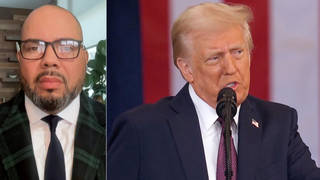
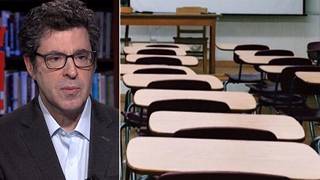
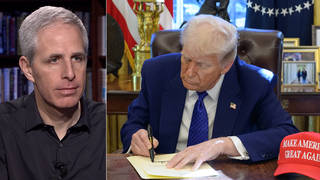
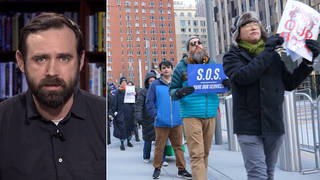

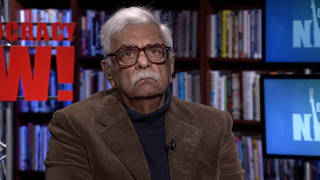
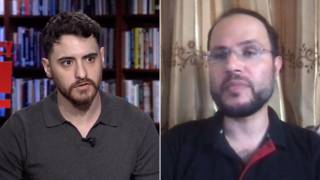
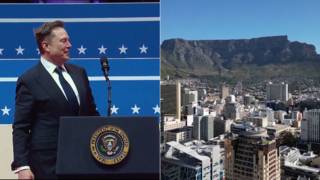

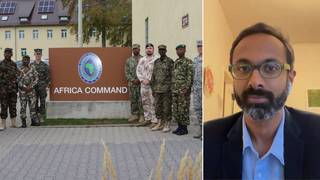
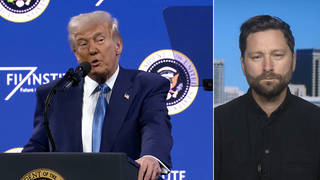
Media Options